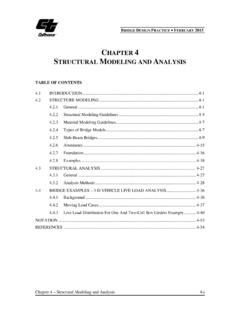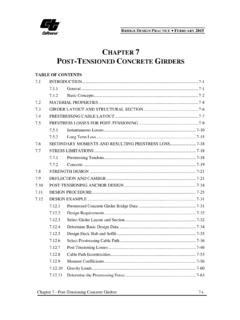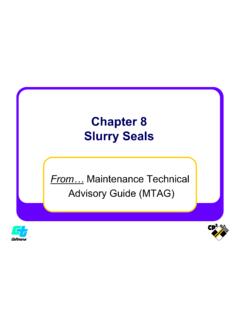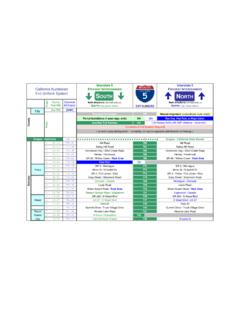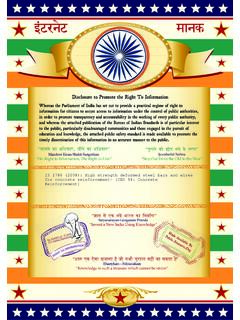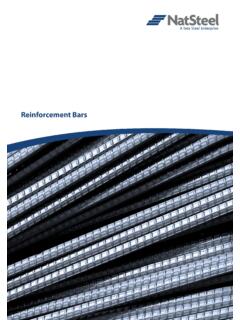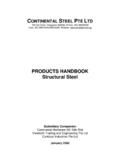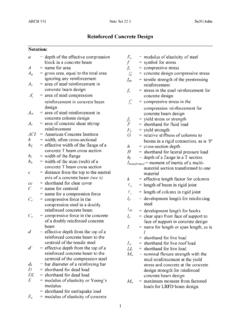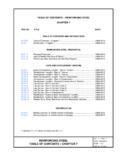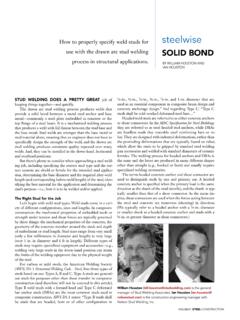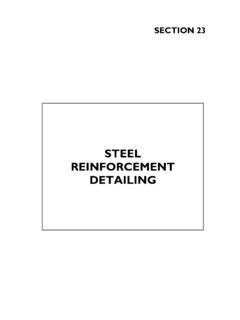Transcription of Section 4: PRESTRESSING STRANDS/BARS - Caltrans
1 Section 4 FEBRUARY 2014. Section 4: PRESTRESSING STRANDS/BARS . The base material used to fabricate PRESTRESSING steel must conform to the requirements of ASTM. A416 or A722, and the Standard The A416 designation covers the requirements for both ( mm) and ( mm) strands. The A722 designation gives requirements for high-strength steel bars. Figures 4-2, 4-3, and 4-4 show typical stress-strain curves and physical properties for ( mm), ( mm) strand, and grade 150 ksi (1030 MPa). bars. Figure 4-1 Low-Lax Strand Manufacturing Process. 18. 2010 SS, Section , PRESTRESSING steel . Caltrans PRESTRESS MANUAL 4- 1. Section 4 FEBRUARY 2014. All strands are the seven-wire type with a center wire enclosed by six helically placed outer wires. The center wire is slightly larger than the outer six wires. Strand is stress relieved by continuous heat treatment, a process that produces a slight bluish tint to the strands. The process of fabricating low-lax strand is schematically shown in Figure 4-1.
2 The ASTM specifications allow one butt-welded wire per 150 feet ( m) of strand, but only during the fabrication process. Under no circumstances should welding of joints in strands or wires be allowed in the field. The Standard Specifications19 allow the use of couplers for extending plain or deformed bars. The coupled unit must have a tensile strength of not less than the manufacturer's minimum guaranteed ultimate tensile strength of the bars. Figure 4-2 Typical Stress-Strain Curve for inch ( mm) 270. ksi (1860 MPa) Strand 19. 2010 SS, Section , PRESTRESSING steel . Caltrans PRESTRESS MANUAL 4- 2. Section 4 FEBRUARY 2014. Figure 4-3 Typical Stress-Strain Curve for inch ( mm) 270 ksi (1860 MPa) Strand. The locations of couplers are subject to approval of the Engineer and must be shown on the Contractor's shop drawings. Effective packaging of PRESTRESSING steel is necessary to protect the material from physical damage and corrosion. The packaging should be inspected for physical damage immediately upon arriving at the jobsite.
3 Any damaged pack must be replaced or restored to its original condition. The shipping package or form must be clearly marked with a statement that the package contains high-strength PRESTRESSING steel , and the type of corrosion inhibitor used, including the date packaged. A release tag will be delivered with the strands. The release tags attached to the individual packs will have the area (A), and the modulus of elasticity (E) of the strand, as determined by Materials Engineering and Testing Services (METS). Collect one of the tags and initial the remaining tags. On the collected tag, record the (A's and E's), and attach to a TL-29 for the job records. In addition, obtain the material properties (A's and E's) as determined by the manufacturer from each individual strand pack. The manufacturer's material properties will be used to calculate elongations during the stressing operation. Caltrans PRESTRESS MANUAL 4- 3. Section 4 FEBRUARY 2014. Prior to placement, it is important that PRESTRESSING steel be checked for corrosion or damage.
4 A. very small pit or crack in high-strength wire or bar will allow a stress concentration at that point and could cause an abrupt failure of an individual bar or wire. Tests performed by METS on rods with 1/32 ( mm) deep pits resulted in reductions of strength varying up to 50 percent. Figure 4-4 Typical Stress-Strain Curve for 1 inch ( mm) Grade 150 (1030. MPa) deformed Bar. The Standard Specifications20 states that all PRESTRESSING steel be protected at all times against physical damage and rust or other results of corrosion, from manufacture to grouting or encasing in concrete. PRESTRESSING steel that has sustained physical damage at any time must be rejected. 20. 2010 SS, Section , PRESTRESSING steel . Caltrans PRESTRESS MANUAL 4- 4. Section 4 FEBRUARY 2014. The following is presented as a guide for inspection of PRESTRESSING steel for rust before installation in ducts: 1. Upon opening, if there is an even coating of rust over the strands in the entire pack, the pack should be rejected.
5 This situation indicates improper handling or storage. 2. If there are one or more wires in a strand that shows extensive rust throughout its length, the entire pack should be rejected. The wire was probably rusty when the strand was wound. 3. When there are spots of rust on a portion of strands in the pack, especially on the inside of the coil, this is the likely effect of condensation, usually caused by temperature changes during shipment or storage. If rubbing or scraping with your fingernail can remove these spots, the steel is acceptable. If light streaks of rust remain, the steel is still acceptable if pitting is not present. 4. Short sections of strand that contain clinging rust, pits, or other flaws should be rejected without rejecting the entire pack. The above criteria can generally be applied to bars as well as strand. In addition, loose mill scale on bars should be removed in a manner that will not damage the material. Prior to rejecting PRESTRESSING steel , contact the Structure Representative or Bridge Construction Engineer (BCE).
6 The PRESTRESSING steel must be checked for rust and other flaws, as described above, before it is pushed into ducts or while the tendons are being made up. During the placement operation, inspection should also be provided for proper make-up of tendons, and for care in keeping the steel and ducts clean and free from any foreign material or damage from handling. PRESTRESSING steel should preferably be cut with a carborundum blade. Flame cutting may be used provided proper care can be exercised near anchorages. Cold chiseling should be avoided near anchorages. Exposure to electrical current, for example arc welding, as a general practice is currently not allowed in the specifications. If the Contractor proposes arc welding, the circumstances and method must be reviewed and authorized by Structure Construction Headquarters (SC HQ) and the State Bridge Engineer, with approval on a case-by-case basis. A corrosion inhibitor must be applied if PRESTRESSING steel is placed in ducts prior to placing and curing of concrete.
7 If the steel is placed after placement of the concrete, a corrosion inhibitor is required if the stressing and grouting are not completed within 10 days. The Contractor must provide an authorized corrosion inhibitor that prevents rust or corrosion. Corrosion inhibitors must not have a deleterious effect on the steel , concrete, or bond strength of the steel to concrete. Vapor Phase Inhibitors (VPI) are materials commonly used by contractors to protect PRESTRESSING strand. When properly applied, the powder volatizes (changes to a vapor), coating the metal surfaces to form an invisible film. Vapor Phase Inhibitors protect metal electrochemically. The manufacturer's recommendations should be used when applying the powder. The ducts must be reasonably dry. The powder is applied into the ducts by use of a floc gun. The application concentration for VPI Powder is typically (300-500 g/m3) of enclosed space. Caltrans PRESTRESS MANUAL 4- 5. Section 4 FEBRUARY 2014. The Contractor must include provisions for placing VPI on the shop drawings.
8 The provisions must include the manufacturer's technical data, application rate, and a Material Safety Data Sheet. Contractors may propose the use of other types of corrosion inhibitors. On segmental construction either cast-in-place or precast, contractors will typically leave installed prestress tendons ungrouted for periods of time which exceed the standard specifications limit of 10 days. This is due to the risk of cross grouting into empty ducts which occur due to the sequential stressing sequences common to segmental bridge construction. Photo 4-7 Installation of Individual Strands Photo 4-8 Strand Packs on Bridge Deck. by Pushing. Photo 4-9 Dirt Free PRESTRESSING Tendon. Photo 4-10 Tendon Installed with Pulling Cuff Caltrans PRESTRESS MANUAL 4- 6. Section 4 FEBRUARY 2014. Photo 4-11 Tendon Pulling Machine. Photo 4-12 Cal-Wrapped Strand Packs. Photo 4-13 Strand, Wedge, and Anchor Head Photo 4-14 Sumiden Cold-drawing Process. Caltrans PRESTRESS MANUAL 4- 7.
